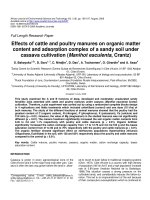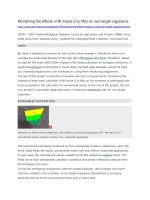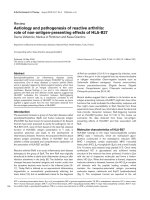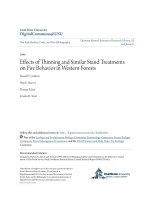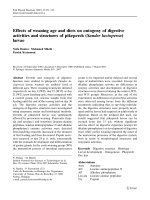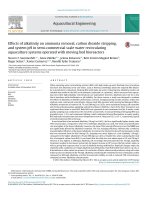Effects of dietary n-3 and n-6 fatty acids levels on egg and larval quality of Eurasian perch pdf
Bạn đang xem bản rút gọn của tài liệu. Xem và tải ngay bản đầy đủ của tài liệu tại đây (586.94 KB, 2 trang )
Effects of dietary n-3 and n-6 fatty acids levels on egg
and larval quality of Eurasian perch
by
Émilie HENROTTE (1), Julia Lynne OVERTON (2) & Patrick KESTEMONT (1)
ABSTRACT. - Three groups of 40 perch breeders were reared in order to study the effects of 3 different levels of dietary
n-3 and n-6 fatty acids on egg quality. Two experimental diets, R1 and R2 (n-3/n-6 = 0.13 and 35.54, respectively), were
compared to one commercial food, R3 (n-3/n-6 = 3.48). Spawning and fertilization rates were high for diets R1 and R3,
which displayed a n-3/n-6 ratio of 0.77 and 2.34 in the eggs, respectively, by comparison with R2 (n-3/n-6 = 4.87), which
produced low reproductive performances. We can conclude that dietary n-3 and n-6 FA levels inuence egg and larval
quality of Eurasian perch.
Key words. - Perca uviatilis - Egg quality - Fatty acids.
Cybium 2008, 32(2) suppl.: 271-272.
(1) The University of Namur, 61 rue de Bruxelles, 5000 Namur, Belgium. []
(2) Danish Institute of Fisheries Research, Dept. Aquaculture and Marine Ecology, Kavalergården 6, 2920 Charlottenlund, Denmark.
Introduction
One of the major constraints for the development of Eur-
asian perch culture is the supply of good quality eggs. The
importance of 3 fatty acids (FAs; docosahexaenoic (22:6n-3;
DHA), eicosapentaenoic (20:5n-3; EPA) and arachidonic
(20:4n-6; ARA) acids) in the reproduction and egg quality
has been demonstrated (Bell et al., 1997). As a result of
chemical similarities among these particular FAs, leading to
competitive interactions, the optimal requirement for each
individual FA is difficult to assess. The objective of this
study was to determine the FA composition of eggs obtained
from broodstock fed different n-3 and n-6 FAs levels in rela-
tion with reproductive performances, egg quality and larval
robustness.
Methods
Three groups of 40 perch breeders were reared in order
to test different levels of dietary n-3 and n-6 FAs (16% lip-
ids) during 9 months (from March to November 2006). Two
experimental diets, R1 and R2 (n-3/n-6 = 0.13 and 35.54,
respectively), were compared to one commercial sh diet,
R3 (n-3/n-6 = 3.48). Spawning and fertilization rates were
checked in November, and larval robustness was evaluated
by osmotic shock (1 hour in NaCl 2%, 20°C) two days after
hatching. Total lipid and FAs were extracted from the eggs
and tested diets. Data were compared by analysis of variance
ANOVA1 (Statistica 5.5).
Results and discussion
The survival of broodstock was similar among the
three diets. The spawning rate was high for R1 and
R3 (85.7 and 73.3%, respectively) while only few
spawnings were obtained for R2 (33.3%). For 12 egg
strands, only one was fertilized in R2, while 38.9 and
72.7% of the spawnings were fertilized in R1 and R3,
respectively, with similar fertilization rates in these
groups (88.6 ± 10.4 and 87.4 ± 15.1%). Larval robust-
ness was comparable between R1 and R3 (74.2 ± 25.0% and
69.0 ± 24.2% survival, respectively). The present results
show the same relationship between sh diet and FA compo-
sition of the eggs produced. R1 and R3 displayed a n-3/n-6
ratio of 0.77 and 2.34 in the eggs respectively, while the
spawnings obtained for R2 displayed a ratio of 4.87 (Tab. I),
which can be correlated to low reproductive performances,
specically regarding the spawning rate, but also regarding
the percentage of fertilized spawnings. Our results indicate
that the spawning quality of perch is directly affected by the
n-6 FA content of broodstock diet. As opposed to mammal
cells, which contain essentially n-6 FAs in their PUFA, sh
cells contain a high level of EPA and DHA, and, consequent-
ly, need those FAs in their diet. However, despite the elevat-
ed levels of EPA and DHA, ARA is the chief precursor of the
eicosanoids, generating 2-series prostanoids (Lands, 1989),
which may act on the induction process of the ovulation as
well as on spawning.
Conclusion
It is possible to improve the reproductive performances
as well as the egg and larval quality in Eurasian perch by
manipulating the fatty acid composition of the broodstock
diet.
Acknowledgements. - This work was support by the European
Union CRAFT Percatech project (COOPT-CT-2004-512629) and
by a FRIA grant.
Table I. - Fatty acid composition of eggs of Eurasian perch (% of total FAs).
Signicant differences (p < 0.05) are indicated with different letters.
References
BELL J.G., FARNDALE B.M., BRUCE M.P., NAVAS J.M. & M.
CARILLO, 1997. - Effects of broodstock dietary lipid on fatty
acid compositions of eggs from sea bass (Dicentrarchus
labrax). Aquaculture, 149: 107-119.
LANDS, W.E.M., 1989. - Differences in n-3 and n-6 eicosanoid
precursor. In: Advances in prostaglandin, thromboxane and leu-
kotriene research (Samuelsson B., Wong P.Y.K. & F.F. Sun,
eds), pp. 602-605. New York: Raven Press.
Eurasian perch egg and larval quality
He n r o t t e e t a l .
272 Cybium 2008, 32(2) suppl.

